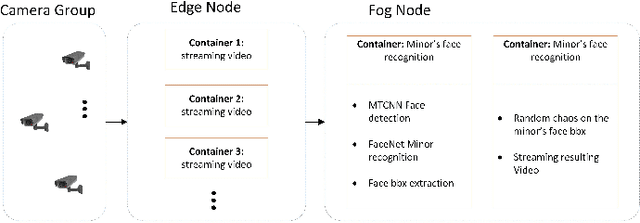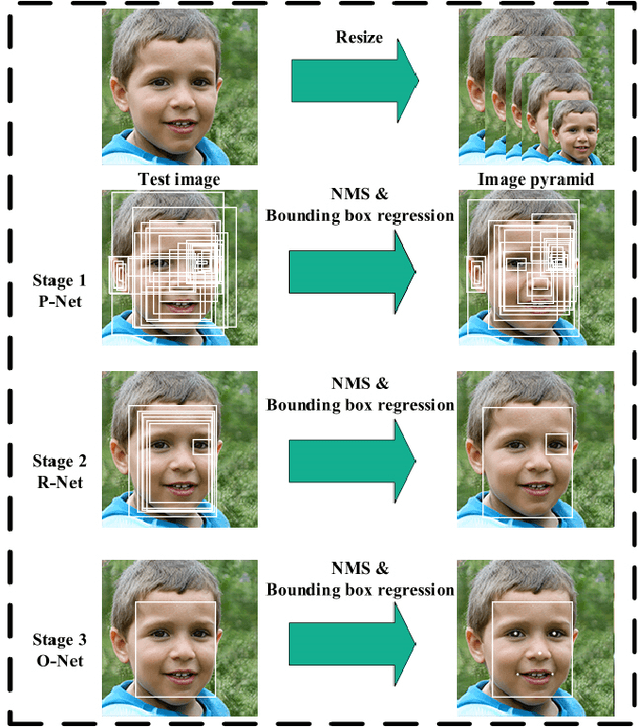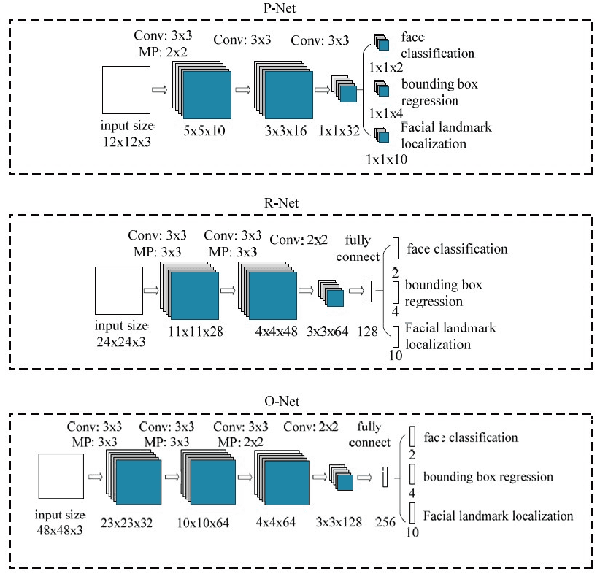Seyed Yahya Nikouei
Minor Privacy Protection Through Real-time Video Processing at the Edge
May 03, 2020



Abstract:The collection of a lot of personal information about individuals, including the minor members of a family, by closed-circuit television (CCTV) cameras creates a lot of privacy concerns. Particularly, revealing children's identifications or activities may compromise their well-being. In this paper, we investigate lightweight solutions that are affordable to edge surveillance systems, which is made feasible and accurate to identify minors such that appropriate privacy-preserving measures can be applied accordingly. State of the art deep learning architectures are modified and re-purposed in a cascaded fashion to maximize the accuracy of our model. A pipeline extracts faces from the input frames and classifies each one to be of an adult or a child. Over 20,000 labeled sample points are used for classification. We explore the timing and resources needed for such a model to be used in the Edge-Fog architecture at the edge of the network, where we can achieve near real-time performance on the CPU. Quantitative experimental results show the superiority of our proposed model with an accuracy of 92.1% in classification compared to some other face recognition based child detection approaches.
I-ViSE: Interactive Video Surveillance as an Edge Service using Unsupervised Feature Queries
Mar 09, 2020



Abstract:Situation AWareness (SAW) is essential for many mission critical applications. However, SAW is very challenging when trying to immediately identify objects of interest or zoom in on suspicious activities from thousands of video frames. This work aims at developing a queryable system to instantly select interesting content. While face recognition technology is mature, in many scenarios like public safety monitoring, the features of objects of interest may be much more complicated than face features. In addition, human operators may not be always able to provide a descriptive, simple, and accurate query. Actually, it is more often that there are only rough, general descriptions of certain suspicious objects or accidents. This paper proposes an Interactive Video Surveillance as an Edge service (I-ViSE) based on unsupervised feature queries. Adopting unsupervised methods that do not reveal any private information, the I-ViSE scheme utilizes general features of a human body and color of clothes. An I-ViSE prototype is built following the edge-fog computing paradigm and the experimental results verified the I-ViSE scheme meets the design goal of scene recognition in less than two seconds.
I-SAFE: Instant Suspicious Activity identiFication at the Edge using Fuzzy Decision Making
Sep 12, 2019



Abstract:Urban imagery usually serves as forensic analysis and by design is available for incident mitigation. As more imagery collected, it is harder to narrow down to certain frames among thousands of video clips to a specific incident. A real-time, proactive surveillance system is desirable, which could instantly detect dubious personnel, identify suspicious activities, or raise momentous alerts. The recent proliferation of the edge computing paradigm allows more data-intensive tasks to be accomplished by smart edge devices with lightweight but powerful algorithms. This paper presents a forensic surveillance strategy by introducing an Instant Suspicious Activity identiFication at the Edge (I-SAFE) using fuzzy decision making. A fuzzy control system is proposed to mimic the decision-making process of a security officer. Decisions are made based on video features extracted by a lightweight Deep Machine Learning (DML) model. Based on the requirements from the first-line law enforcement officers, several features are selected and fuzzified to cope with the state of uncertainty that exists in the officers' decision-making process. Using features in the edge hierarchy minimizes the communication delay such that instant alerting is achieved. Additionally, leveraging the Microservices architecture, the I-SAFE scheme possesses good scalability given the increasing complexities at the network edge. Implemented as an edge-based application and tested using exemplary and various labeled dataset surveillance videos, the I-SAFE scheme raises alerts by identifying the suspicious activity in an average of 0.002 seconds. Compared to four other state-of-the-art methods over two other data sets, the experimental study verified the superiority of the I-SAFE decentralized method.
Smart Surveillance as an Edge Network Service: from Harr-Cascade, SVM to a Lightweight CNN
Oct 01, 2018



Abstract:Edge computing efficiently extends the realm of information technology beyond the boundary defined by cloud computing paradigm. Performing computation near the source and destination, edge computing is promising to address the challenges in many delay-sensitive applications, like real-time human surveillance. Leveraging the ubiquitously connected cameras and smart mobile devices, it enables video analytics at the edge. In recent years, many smart video surveillance approaches are proposed for object detection and tracking by using Artificial Intelligence (AI) and Machine Learning (ML) algorithms. This work explores the feasibility of two popular human-objects detection schemes, Harr-Cascade and HOG feature extraction and SVM classifier, at the edge and introduces a lightweight Convolutional Neural Network (L-CNN) leveraging the depthwise separable convolution for less computation, for human detection. Single Board computers (SBC) are used as edge devices for tests and algorithms are validated using real-world campus surveillance video streams and open data sets. The experimental results are promising that the final algorithm is able to track humans with a decent accuracy at a resource consumption affordable by edge devices in real-time manner.
Real-Time Human Detection as an Edge Service Enabled by a Lightweight CNN
Apr 24, 2018



Abstract:Edge computing allows more computing tasks to take place on the decentralized nodes at the edge of networks. Today many delay sensitive, mission-critical applications can leverage these edge devices to reduce the time delay or even to enable real time, online decision making thanks to their onsite presence. Human objects detection, behavior recognition and prediction in smart surveillance fall into that category, where a transition of a huge volume of video streaming data can take valuable time and place heavy pressure on communication networks. It is widely recognized that video processing and object detection are computing intensive and too expensive to be handled by resource limited edge devices. Inspired by the depthwise separable convolution and Single Shot Multi-Box Detector (SSD), a lightweight Convolutional Neural Network (LCNN) is introduced in this paper. By narrowing down the classifier's searching space to focus on human objects in surveillance video frames, the proposed LCNN algorithm is able to detect pedestrians with an affordable computation workload to an edge device. A prototype has been implemented on an edge node (Raspberry PI 3) using openCV libraries, and satisfactory performance is achieved using real world surveillance video streams. The experimental study has validated the design of LCNN and shown it is a promising approach to computing intensive applications at the edge.
 Add to Chrome
Add to Chrome Add to Firefox
Add to Firefox Add to Edge
Add to Edge